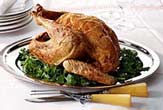Talking Turkey: Tips on How to Eat the Bird Safely

Thanksgiving Day is typically celebrated by gorging ourselves with yummy turkey and stuffing, and of course counting our blessings. But before the bird hits the table, there's much to be done to ensure not only a juicy meal, but also one free of harmful bugs.
Fixings for the big T-day are complicated, said Ben Chapman, food safety specialist and assistant professor of food science at North Carolina State University.
But if you follow some simple advice in the kitchen, there's a good chance it'll go off without a hitch or a bellyache.
Thaw your turkey. If you're frying a turkey, make sure it's thawed first. Plopping a frozen bird into a pot of hot oil could lead to a fiery explosion — an event that may be due to both the turkey's temperature and water content. "It has to do with the temperature change. You're putting something really cold into something really hot and that affects what the oil is going to do," Chapman said, adding that this "exploding turkey" phenomenon is outside his expertise. [Infographic: Avoid a Fried Turkey Disaster]
"I had guessed that the water in the turkey, or whatever, boils very fast causing the surface to explode with bubbles, some of which could spray oil on the burner," John Coupland, associate professor of food science at Penn State, said in an e-mail to LiveScience. "So wet rather than cold is the key variable."
As for where to defrost the bird, Chapman recommends placing it in the fridge, microwave, or under cool water. All methods, however, come with their own risks. For instance, you have to make sure the turkey's center gets thawed when in the refrigerator. (The garage is not a good place for turkey thawing, as you can't control the external temperature there, and it could rise above 41 degrees Fahrenheit (5 degrees Celsius), which is prime growing condition for Salmonella and Campylobacter, the two most common pathogens associated with turkey.)
According to the United States Department of Agriculture, here are guidelines for thawing a whole turkey in the refrigerator:
Get the world’s most fascinating discoveries delivered straight to your inbox.
- 4 to 12 pounds: one to three days
- 12 to 16 pounds: three to four days
- 16 to 20 pounds: four to five days
- 20 to 24 pounds: five to six days
Don't wash the turkey. What?! "As soon as you have the pressure of the water hitting the turkey it can spray anything on the outside of that turkey around the kitchen," Chapman told LiveScience. Researchers in the United Kingdom recently found that forceful water hitting a turkey could spray its pathogens up to 3 feet (about 1 meter) away.
Chapman recommends wiping the outside of the bird with a damp rag, and then immediately throwing that rag into the washing machine. "Treat that damp rag like a raw chicken," he said, adding that it likely contains the pathogens you're trying to avoid.
Cook that bird. "The most important thing is cooking that turkey to 165 degrees Fahrenheit (74 degrees Celsius), and there's only one way to know whether you've cooked it safely and that is to use a thermometer."
Campylobacter and Salmonella can't grow until the temperature hits 41 degrees F, and they are killed off when the thermometer reaches 165 degrees F.
While turkey juices do change from raw-meat pink to a clear color as the bird cooks, that doesn't equate with safe eating. Here's how to measure a turkey's doneness: Stick a tip-sensitive digital thermometer into perhaps eight to 10 spots on the turkey. If the thermometer reads at least 165 degrees F all around, it can come out. Chapman says to target areas of thick muscle away from the turkey cavity and bone, since the bone conducts heat much better than does the meat and so could give you a false reading.
Quick, get the bird in the fridge. As soon as the meal is done, Chapman suggests getting the turkey meat into the refrigerator, because if any pathogens were left on the meat they could start growing as soon as temperatures get below about 135 degrees F (57 degrees C).
And even if you've zapped all the harmful bacteria in the oven, there's lots of opportunity for new pathogens to take up residence in your turkey meat between the oven and fridge. For instance, Staphylococcus aureus lives on most of us around our eyes and noses. But it doesn't release its toxins until it has a food source, like turkey meat. Scratching your nose or rubbing an eye while handling the turkey could give the staph a ride onto the food. The cold temperatures in your fridge will slow down growth, keeping the pathogen at safe levels.
Chapman generally places small portions of meat stripped from the bone into plastic bags to increase the surface area that gets exposed to the fridge's cold temperatures.
Some of the classic outbreaks Chapman has seen in which large turkeys were involved had to do with cooling the bird incorrectly, say, leaving it sitting out on a counter for four to five hours.
Leftovers: do it again. And when it's time for Thanksgiving leftovers, pull out the digital thermometer, because Chapman says the same guidelines apply to already-cooked turkey. Even if you heat it up in the microwave, checking several spots to ensure they've all reached a bacteria-blasting 165 degrees F, is smart.
Jeanna Bryner is managing editor of Scientific American. Previously she was editor in chief of Live Science and, prior to that, an editor at Scholastic's Science World magazine. Bryner has an English degree from Salisbury University, a master's degree in biogeochemistry and environmental sciences from the University of Maryland and a graduate science journalism degree from New York University. She has worked as a biologist in Florida, where she monitored wetlands and did field surveys for endangered species, including the gorgeous Florida Scrub Jay. She also received an ocean sciences journalism fellowship from the Woods Hole Oceanographic Institution. She is a firm believer that science is for everyone and that just about everything can be viewed through the lens of science.


